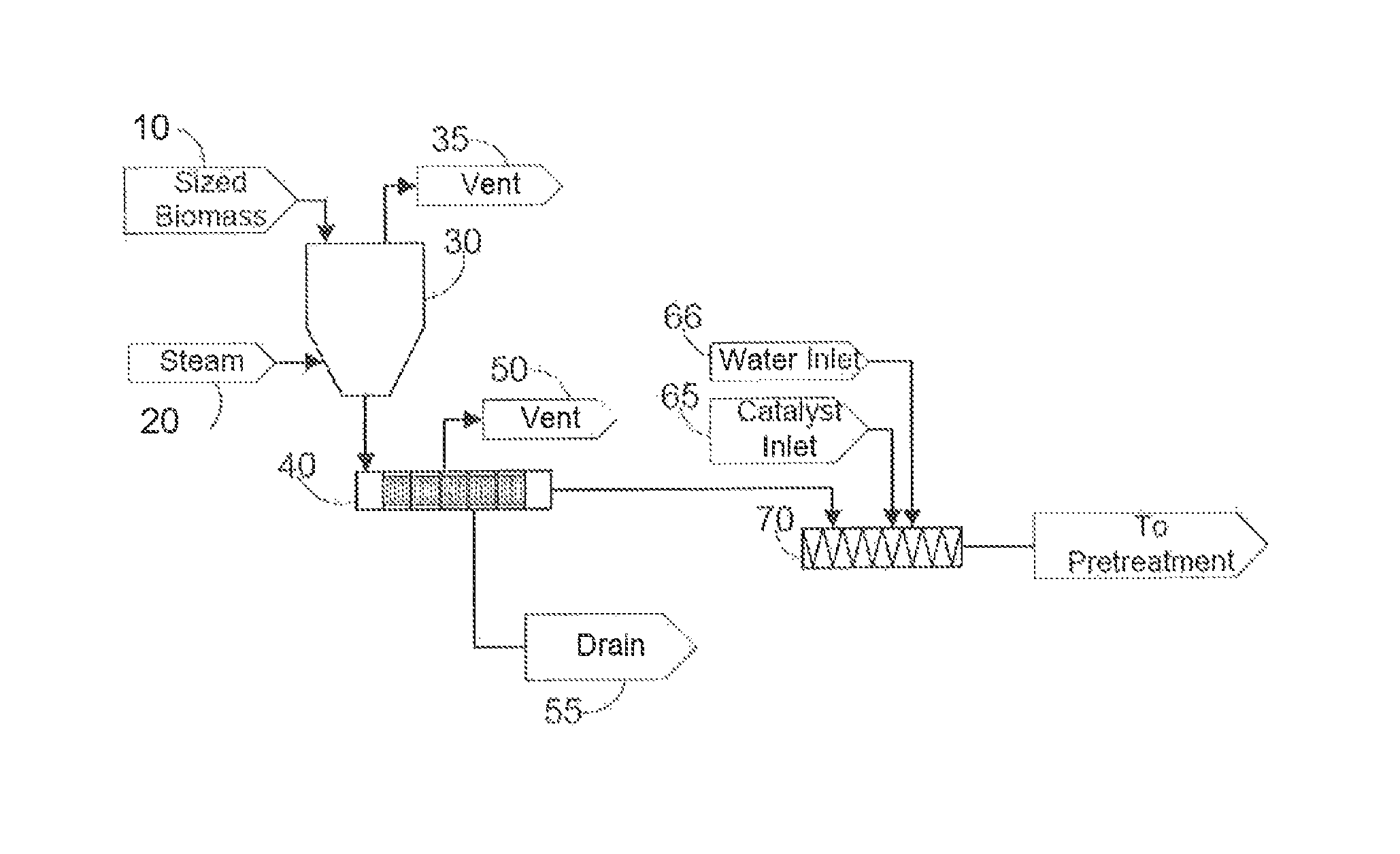Conditioning of biomass for improved C5/C6 sugar release prior to fermentation
a technology of lignocellulosic biomass and c6 sugar, which is applied in the field of conditioning of lignocellulosic biomass, can solve the problems of limited availability of feedstocks, difficult hydrolysis of reactive cellulose from lignocellulosic biomass, and limited use of potential food or feed plants to produce fuel, etc., so as to improve the effect of reducing the content of inhibitory compounds, improving the results, and softening the fibers
- Summary
- Abstract
- Description
- Claims
- Application Information
AI Technical Summary
Benefits of technology
Problems solved by technology
Method used
Image
Examples
example 1
Adjusting Moisture Content Improves Cellulose Digestibility and Hemicellulose Recovery
[0034]
TABLE 1Effect of moisture content in incoming corncobs on recovery of hemicelluloseTable 1. Effect of moisture content in incomingcorn cobs on recovery of hemicelluloseMoisture (%)Incoming cobs69665446352911Hemicellulose Recovery72716259504527(% of incoming)Soluble hemicellulose25324921820717615895sugars (kg / mtdmincoming corn cobs)Hemicellulose sugar21120818217314713279monomers (kg / mtdmincoming corn cobs)
[0035]Table 1 illustrates that hemicellulose sugar recovery increased by greater than 40% as moisture content was increased from 35% to 66%. In order to further increase the ratio of sugar monomers over oligomers, the recovered soluble hemicellulose sugars can be hydrolyzed post recovery either with hemicellulase enzymes or acid catalyst.
[0036]
TABLE 2Effect of moisture content in incoming corn cobson cellulose digestibilityTable 2. Effect of moisture content in incoming corn cobson cellulose ...
example 2
Pre-Heating with Steam Improves Cellulose Digestibility
[0037]Corncobs at 50% moisture were pre-heated with steam at atmospheric pressure with low pressure (5 psig) steam for 10 minutes prior to pre-treatment as described in pending U.S. patent application Ser. No. 12 / 560,843, now U.S. Pat. No. 8,287,651. The results of cellulose digestibility were compared (Table 1) to a control using 1 minute of pre-steaming at 300 psi using super heated steam.
[0038]
TABLE 3Effect of steaming on cellulose digestibilityTable 3. Effect of steaming on cellulose digestibilityand resulting production of glucose monomersSteam heating prior to pretreatment(1) &Pre-treatment conditions (2)10 min, atmosphericGlucose monomers(1) 1 min, 300 psigpressure(kg / mtdm incoming cobs)(2) 235 psig, 8 minEnzyme load0.225342360(% w / w, DM on cobs)0.295368375Table 3. Effect of steaming on cellulose digestibility
[0039]The longer steam heating time reduced the hydrolysis time by 18% to 24% depending on the enzyme dosage. Hemi...
PUM
| Property | Measurement | Unit |
|---|---|---|
| temperature | aaaaa | aaaaa |
| temperature | aaaaa | aaaaa |
| temperature | aaaaa | aaaaa |
Abstract
Description
Claims
Application Information
 Login to View More
Login to View More - R&D
- Intellectual Property
- Life Sciences
- Materials
- Tech Scout
- Unparalleled Data Quality
- Higher Quality Content
- 60% Fewer Hallucinations
Browse by: Latest US Patents, China's latest patents, Technical Efficacy Thesaurus, Application Domain, Technology Topic, Popular Technical Reports.
© 2025 PatSnap. All rights reserved.Legal|Privacy policy|Modern Slavery Act Transparency Statement|Sitemap|About US| Contact US: help@patsnap.com


